| On August
5th, it was a gorgeous day and I decided to forgo my usual Saturday
brunch and take some photos instead. I had gotten started late,
and didn't get outside until about 1:30. I started with a little
tour around the outside of my building, where I found a neat green
bug with yellow margin scampering over a bush. As I turned back
a leaf to see where he'd gone, the little tyke lost his footing
and fell. I soon located him stuck in a spider's web about half
a meter down. |
|
|
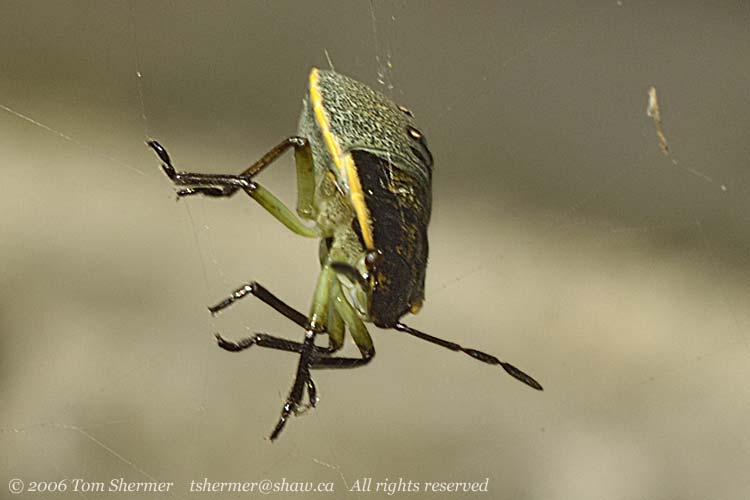 |
| He was a
stink bug in the genus Chlorochroa, and the folks I asked
about him think he's a juvenile but couldn't identify the species.
Here's what his underside looked like. |
|
|
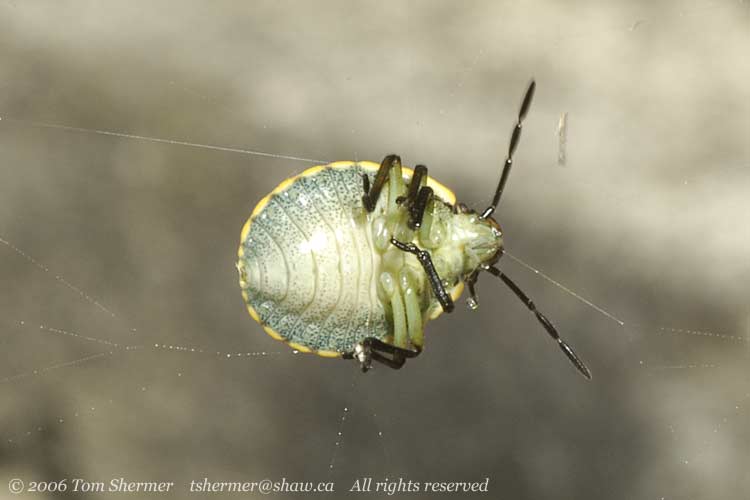 |
|
I liked the little
guy, and since I felt that I might have contributed to his fall,
I freed him from the web and set him on his way.
A little later on my
tour I found an unusual fly. This round-bodied guy is a Tachinid
Fly, from the genus Gymnosoma. I liked the little arrowhead
markings on his abdomen, and the melted-cheese look of the front
of his wings.
|
|
|
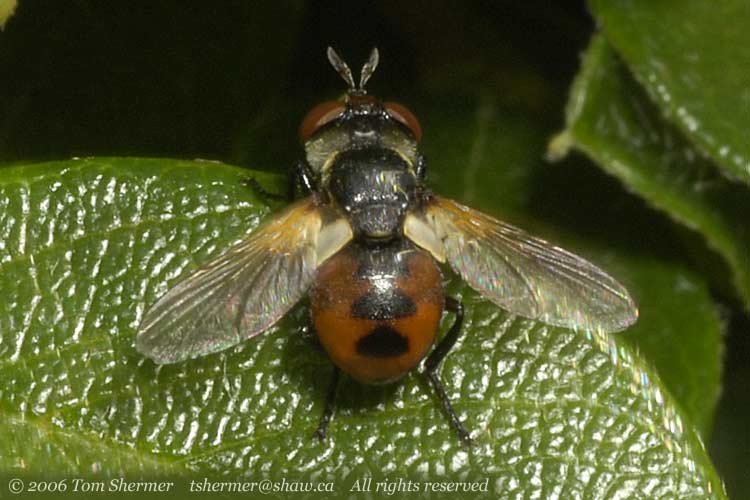 |
|
Two new bugs on one
trip around the building seemed pretty special, but I had bigger
game to hunt that day. My plan was to head out to the Reifel Migratory
Bird Sanctuary, where people had been reporting a trio of Red-necked
Phalaropes. I'd never seen a Red-necked Phalarope before, and
this seemed a good opportunity.
On my way to Reifel,
I stopped along Ladner Trunk Road in Delta when I saw that the
beasts were in the field at the One-Llama Farm. The One-Llama
Farm is my name for this place, which mainly keeps a flock of
sheep. When I first became familiar with the farm (by driving
past it a lot) they had a single llama in amongst the sheep. Llamas
turn out to be really good at scaring off predators and keeping
the peace amongst all those notoriously rowdy sheep; they're better
watchdogs than dogs.
The llama was out there
this time, and I managed to get a decent shot or two of him.
|
|
|
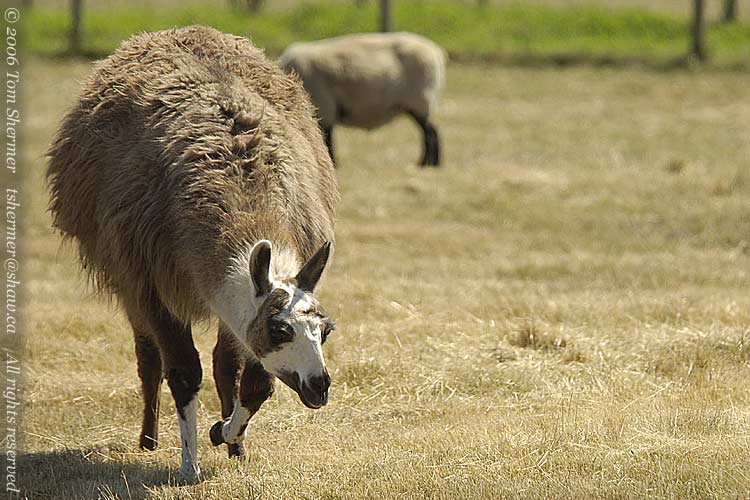 |
| Then I pulled
over to the side road in order to get photos of the sheep. Most
of them were this black-headed type. |
|
|
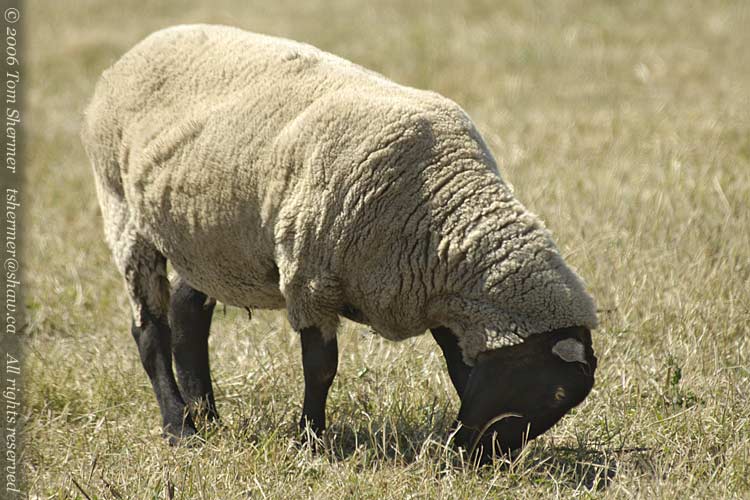 |
| Well, I
found out that I really can't call it the One-Llama Farm anymore,
or I would just be confusing people. It turns out that they've got
two llamas now. I spotted the second llama sitting on a little
hillock, watching the traffic on Ladner Trunk and the highway beyond. |
|
|
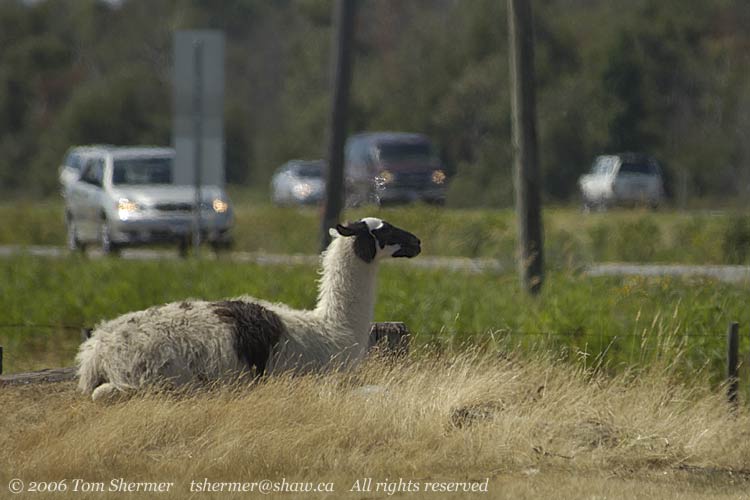 |
|
After a few shots of
llama #2, I left the newly-renamed Two-Llama Farm and was back
on my way to Reifel.
I made it there after
a short stop in Ladner to get a sandwich for lunch. At the refuge,
I was immediately drawn to the regular flock of birds by the parking
lot. A couple of Rock Doves there had caught my attention; they
had particularly nice plumage.
The first one that
I pursued was a brown-morph; they're not as common as the white,
grey, and black ones. Here he was checking out the little seed
that was scattered on the ground.
|
|
|
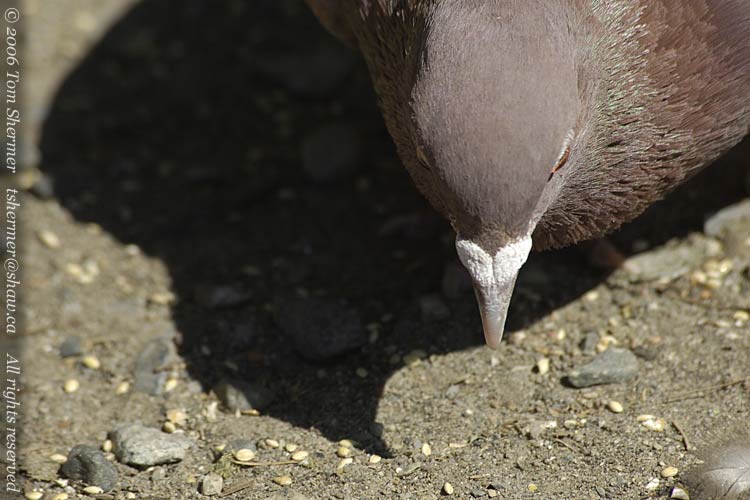 |
| Next, I
went after a pied one who was almost all white. |
|
|
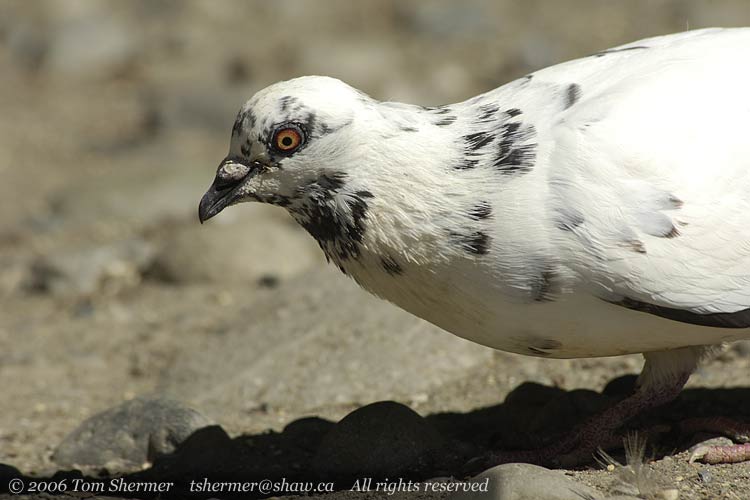 |
| As my white
friend waddled off, I saw a grey one really puff up his neck feathers
and put on a lovely show of colors for his lady. |
|
|
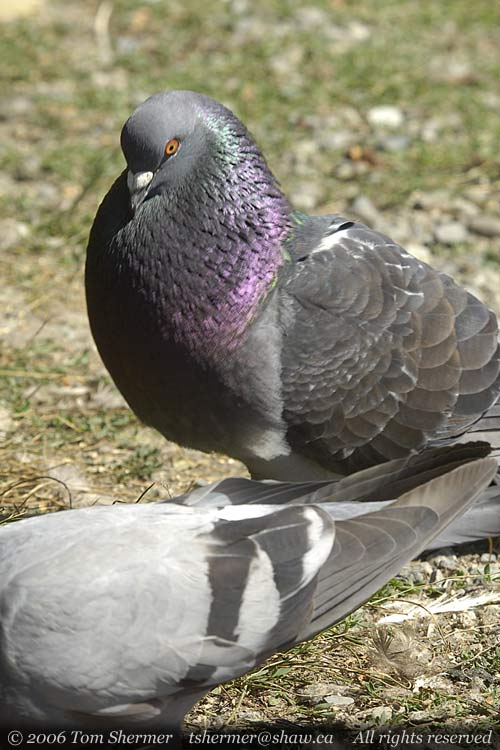 |
| Next, while
still fairly puffed up, he took a look at that lady and then started
chasing her through the flock. Here you can see the start of the
chase; she's already turned tail and is heading away from him. |
|
|
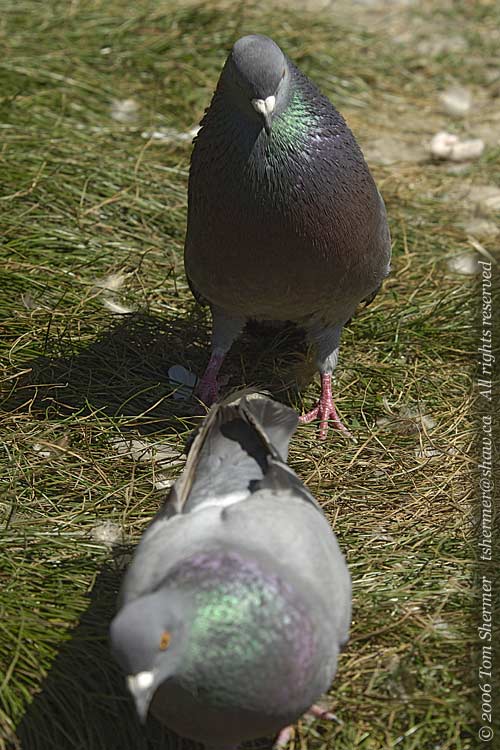 |
|
Naturally, this was
courtship behaviour, and this is why we have so many Rock Doves
in the world. Rock Doves have strong pair bonds and these two
were probably already bonded. This chasing of the female by the
male is a specific behaviour known as driving, and if you
watch a spring or summer flock of doves for a while you're likely
to see it for yourself.
After watching the
doves a little longer, I looked up to see a few Wood Ducks in
the slough, and, well, I have a hard time resisting taking photos
of Wood Ducks, so here's a female for you.
|
|
|
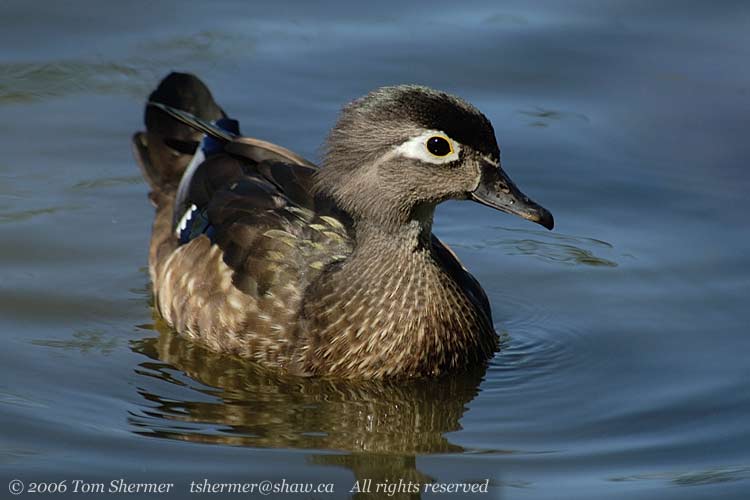 |
|
But after that, I decided
I'd better get on in to the park proper, to try to find those
phalaropes.
I had walked most of
the distance to the viewing tower when I spotted some damselflies
flying around the path in front of me. I positioned myself on
the other (sunward) side of them, and took some shots. The first
one I got was light green with a brown thorax and red eyes; I
wasn't able to identify his species.
|
|
|
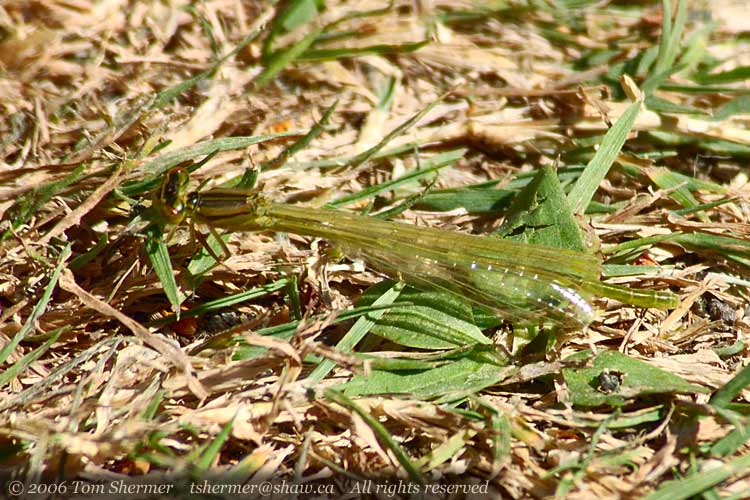 |
| The second
one had orange on the head, a pinkish thorax, and a blue stripe
on the tail. This one I think is an immature female Pacific Forktail.
I had gotten photos of adult Pacific Forktails in the courtyard
at my place a week before. |
|
|
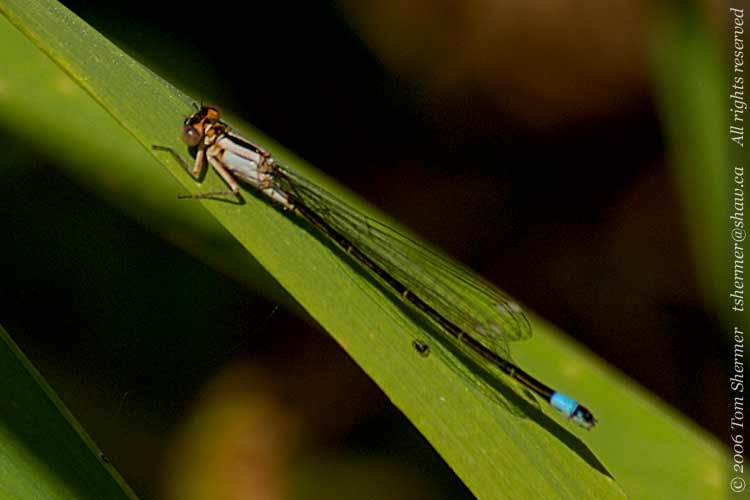 |
|
The phalaropes had
been reported to be hanging out in the north pond. I looked out
over the pond from the base of the tower, but I didn't see them,
so rather than climb the tower (from which it's hard to get good
photos) I decided to walk around the pond on the outer dyke.
About halfway down
the outer dyke, I spotted the birds I was looking for. They were
behind a flock of dowitchers, but had the unmistakable shape of
phalaropes and the correct black-and-white markings for Red-neckeds.
There were indeed three of them; I think the one on the left is
an adult (in nonbreeding plumage) and the other two are juveniles.
The main visible difference between them is that the left one
is lighter grey on the back where the others are a mottled black.
|
|
|
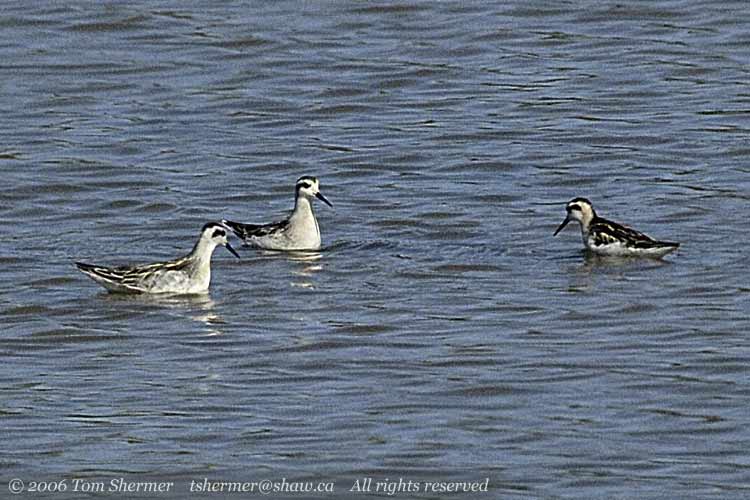 |
| So those
were my lifer Red-necked Phalaropes. I waited around for a while,
watching them swim and feed, and eventually one of the juveniles
got closer to where I was and I was able to get more detailed photos
of him. |
|
|
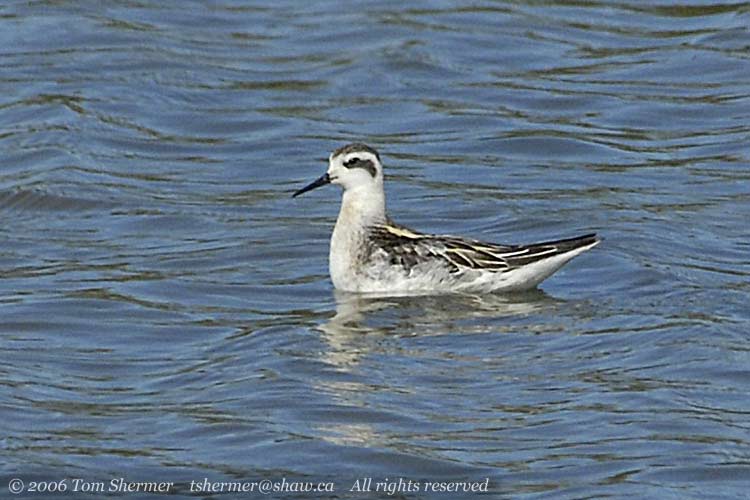 |
| The phalaropes
were swimming around, as is their wont, where the dowitchers were
wading, probing in the mud with their long bills. |
|
|
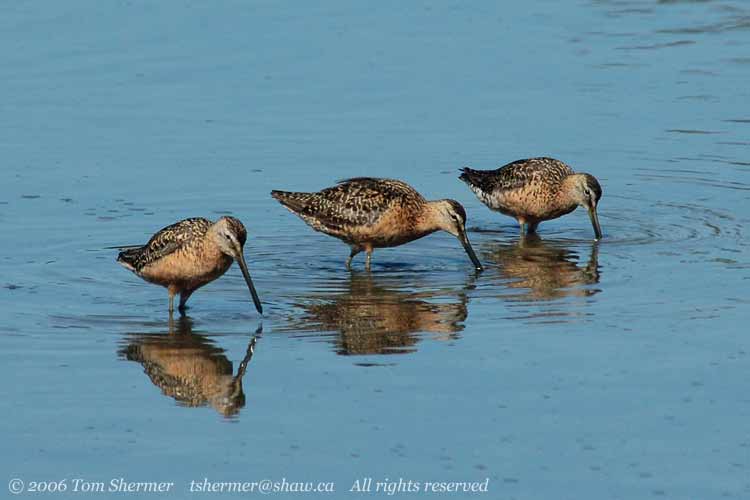 |
| There were
also a few noisy yellowlegs around, like this Greater Yellowlegs. |
|
|
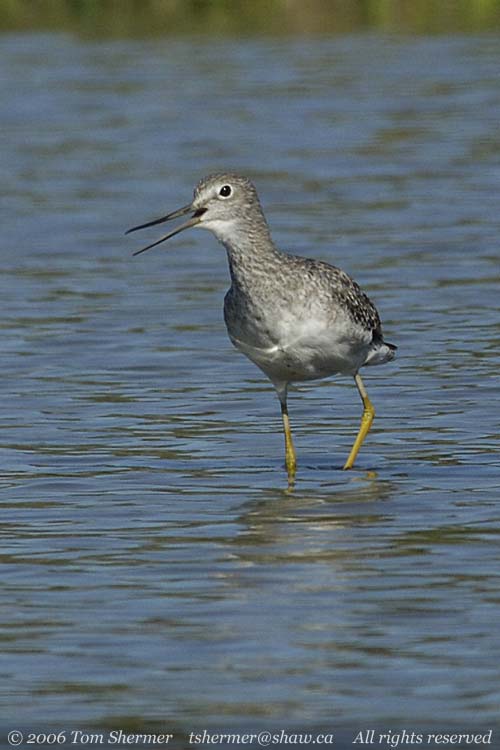 |
| I walked
a little further south along the outer dyke and somehow managed
to spot a very well-camouflaged Killdeer on a small bank that was
covered in molted feathers. |
|
|
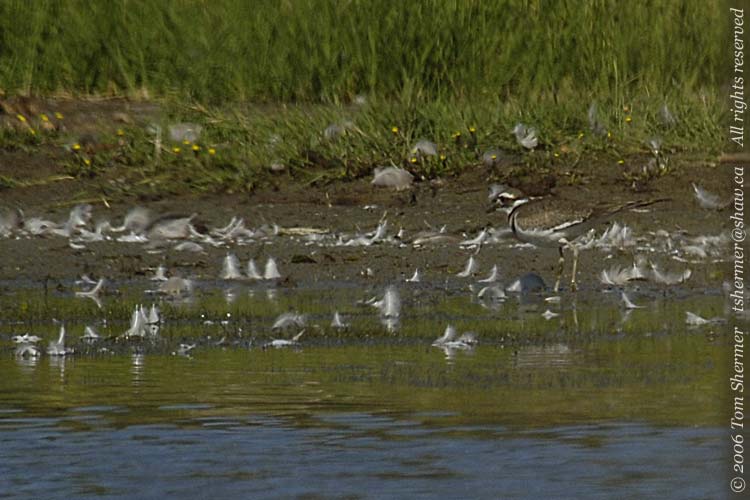 |
| After I
got off a few shots of the Killdeer, a small flock of peeps came
flying in. As far as I can tell, they were all Western Sandpipers,
but some of them may have been Semipalmateds. |
|
|
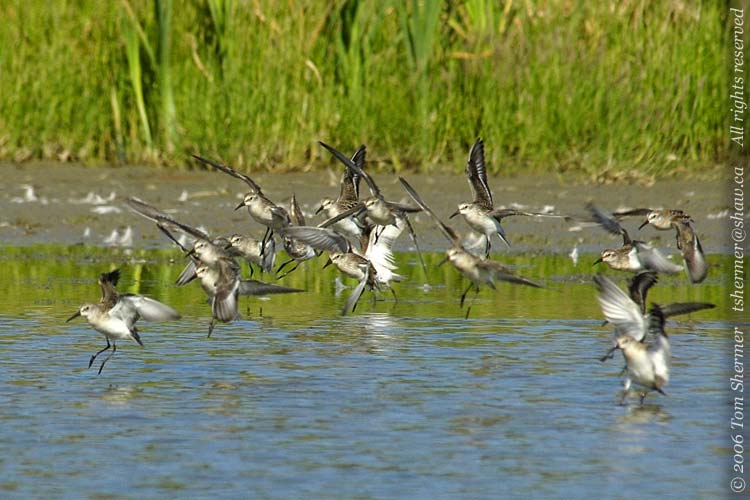 |
| It looked
like they were going to land, but at the last moment they wheeled
around and flew straight towards me. I felt that this one deserved
a wider format than I usually prepare. |
|
|
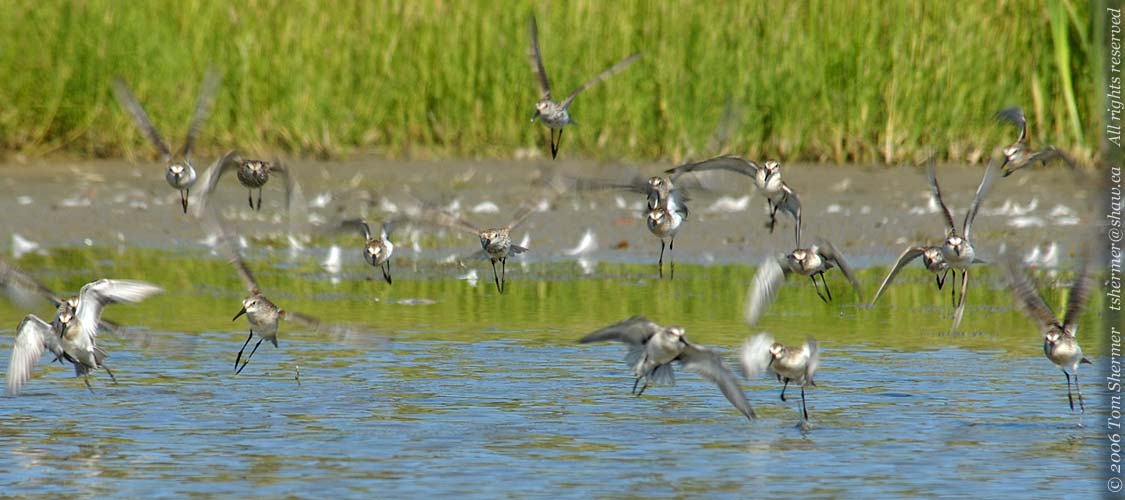 |
| After the
peeps flew by, I found a yellowlegs and his reflection stalking
prey in the nearby water. This one is a Lesser Yellowlegs; he's
got a relatively short bill compared to the other one. |
|
|
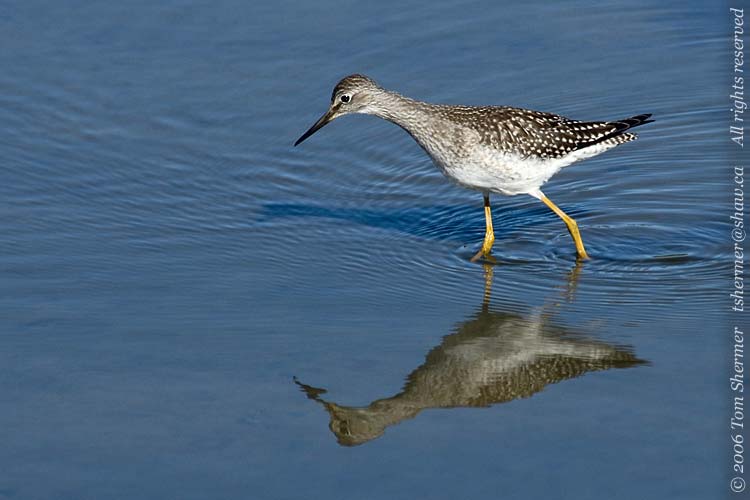 |
| I also managed
to get relatively close to a couple of feeding peeps. This one is
a Semipalmated Sandpiper. |
|
|
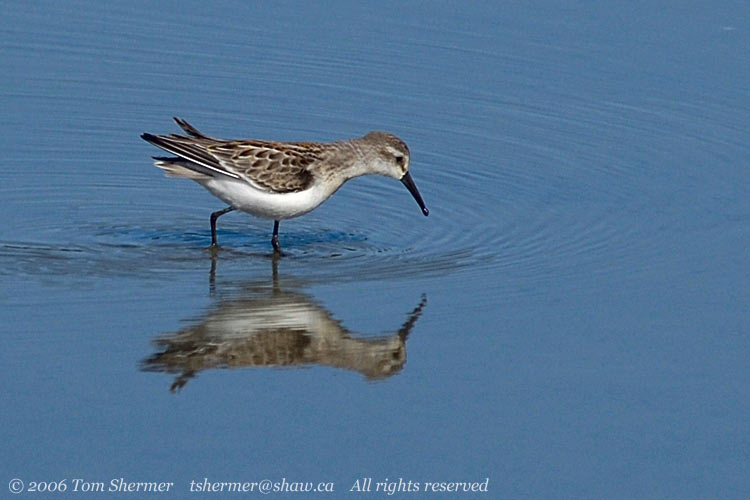 |
|
Palmated
is a term that basically means having webbed feet; these guys
are called semipalmated because they have webbing between
only two of their three toes.
Another peep I found
foraging around was this Least Sandpiper. Leasts are often easy
to identify, because they're the only peep that we regularly get
that has yellow legs.
|
|
|
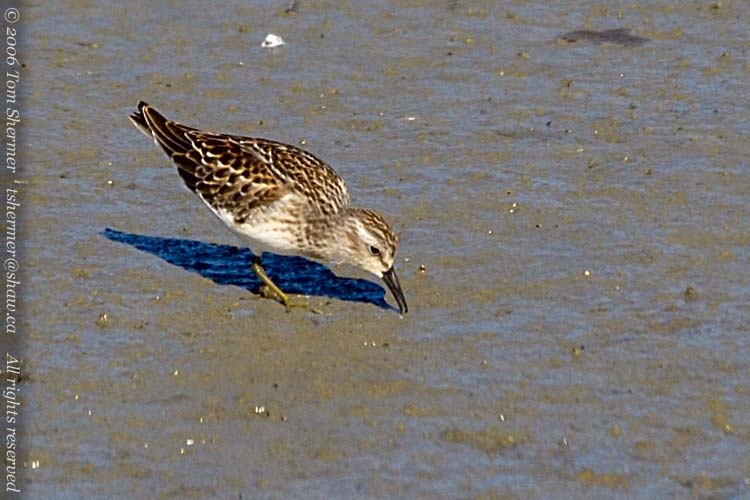 |
| By this
point I had reached the path that divides the north pond from the
south one, and from there I spotted some small ducks which by the
shape I could tell were mergansers of some sort. I wasn't familiar
with the plumage, though, so it wasn't until I got back to the car
and my guide book that I was able to determine that they were juvenile
Hooded Mergansers. |
|
|
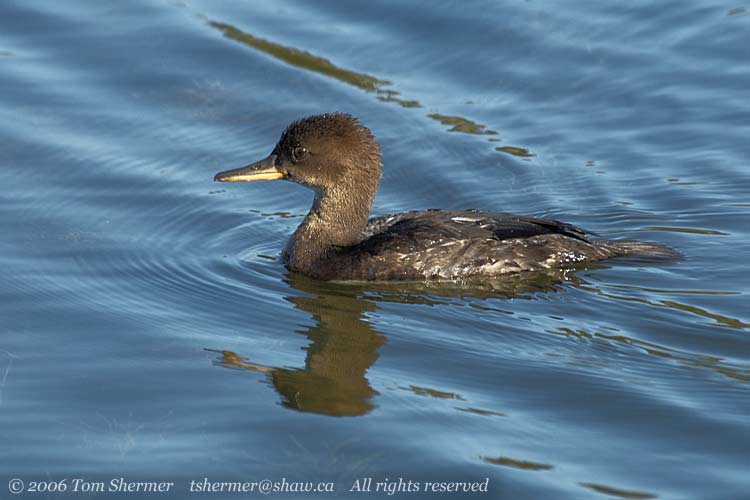 |
|
I opted to go around
the south pond on the outer dyke, rather than heading directly
back to the entrance. I soon found myself looking a collection
of Mallards and yellowlegs sunning themselves on some logs.
|
|
|
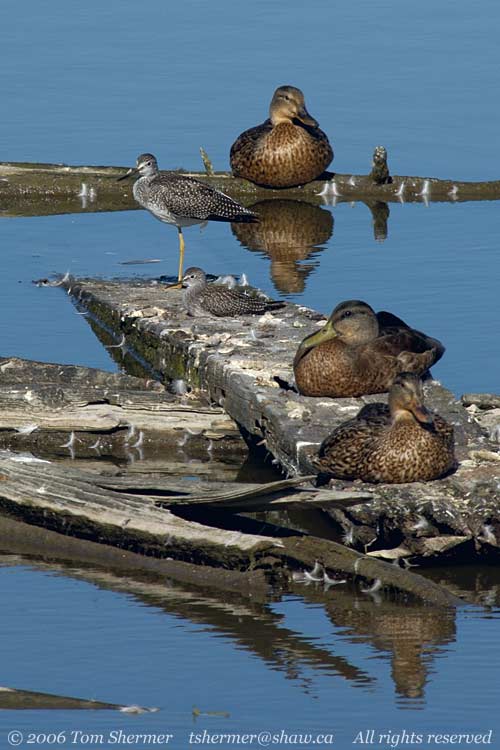 |
|
This was a good opportunity,
because there was a Greater Yellowlegs right next to a Lesser.
Here's a detail of that previous photo, with the Greater in back,
standing, and the Lesser in front, sitting.
|
|
|
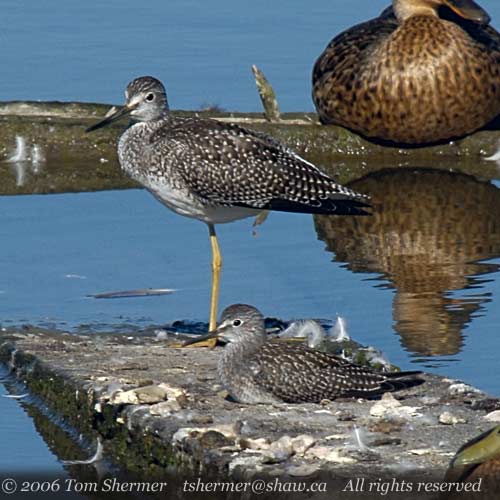 |
|
You might be able to
tell that the bird in the rear is a fair bit bigger than the front
one, and that it's got a much longer bill, relative to the size
of its head. Those, and the width of their legs relative to the
body, are some of the best marks for telling the two species apart.
I wandered along the
dyke, and after a few minutes saw a butterfly on the foreshore
side. The butterfly was big, and it was black and light yellow,
and I thought that it was a Western Tiger Swallowtail, a fairly
common butterfly around the area.
On second thought,
though, I couldn't ever remember having seen a Western Tiger around
sea level, and so I decided that I'd better have a closer look
at this butterfly. I watched it fly around for awhile, and then
lucked out when it lit right next to the path.
|
|
|
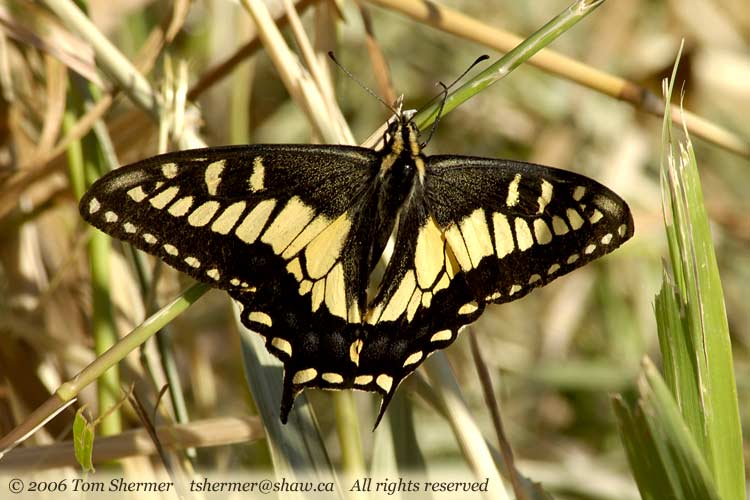 |
|
As I looked at it through
the viewfinder while taking my photos, I noticed that is was a
more black than Western Tigers. It was unmistakably a swallowtail,
though, and it turned out to be an Anise Swallowtail, which was
a new butterfly for me. It's always neat to see new critters...especially
ones with neat colors and patterns.
My next encounter was
with a pair that also had neat colors and patterns, but they weren't
new to me at all. They were my old friends, the Sandhill Cranes.
Although it might be hard to tell we were friends from the way
this one was looking at me.
|
|
|
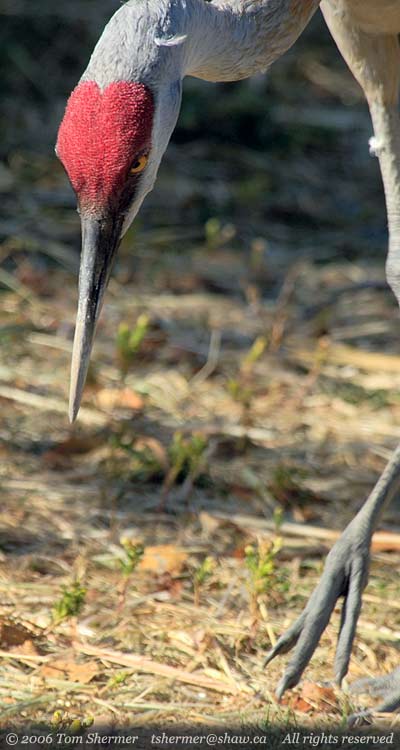 |
| But the
truth is, we are, and soon the cranes were relaxed and preening
themselves. It's at times like this that I'm really thankful that
I don't have to preen—I would get really dizzy if I had to
hold my head upside-down and nip at all my chest hairs. |
|
|
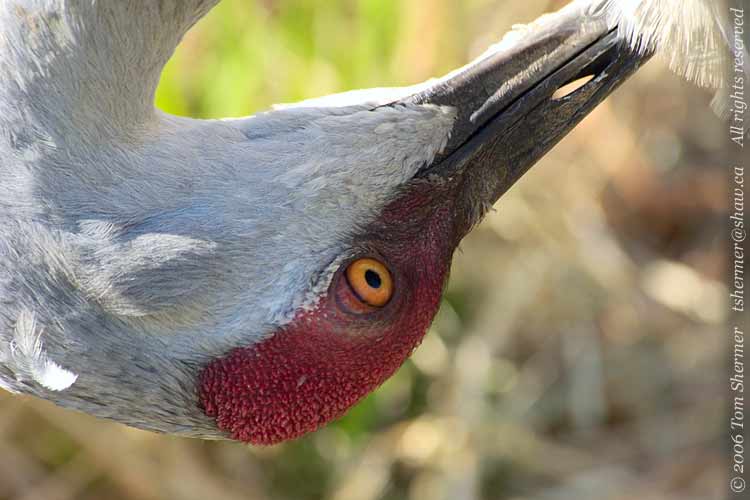 |
|
I was broken from my
preening reverie by a loud squawking commotion from about twenty
meters ahead on the trail. I identified the squawker as a Great
Blue Heron, and that heron was soon airborne and flying past.
I took a few shots as it did so.
|
|
|
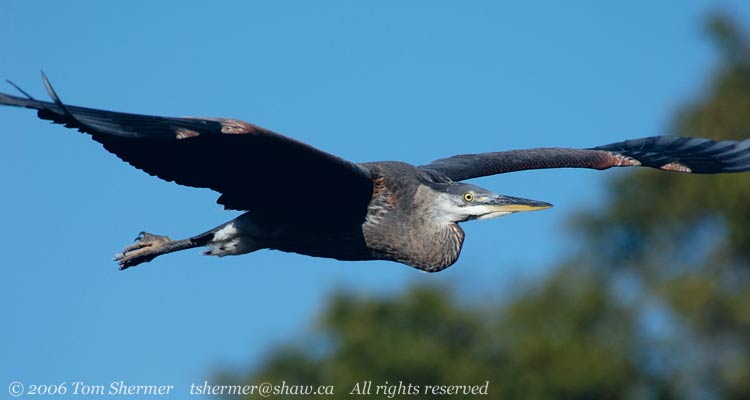 |
|
After that, I made
it back to the entrance to the refuge without encountering further
subjects. Around the entrance, I found some domestic chickens;
there are a number of them that I see in that area regularly.
I love the color on red roosters, so I was not surprised to find
myself getting positioned west of them and trying to get photos
when they crossed from the shadow into the little pools of sunlight.
Here's the best one I got.
|
|
|
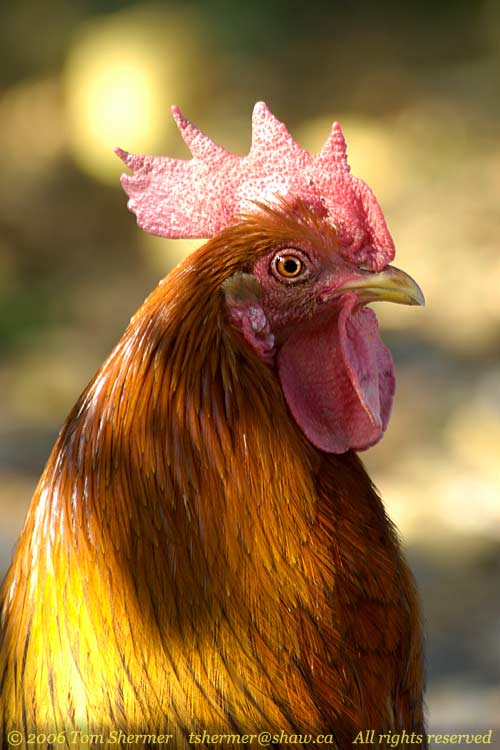 |
|
That was it for the
refuge, and so I headed home.
At home, I made a trip
around the courtyard and found my three-legged friend Easter Bunny
hiding in some vegetation outside his home. |
|
|
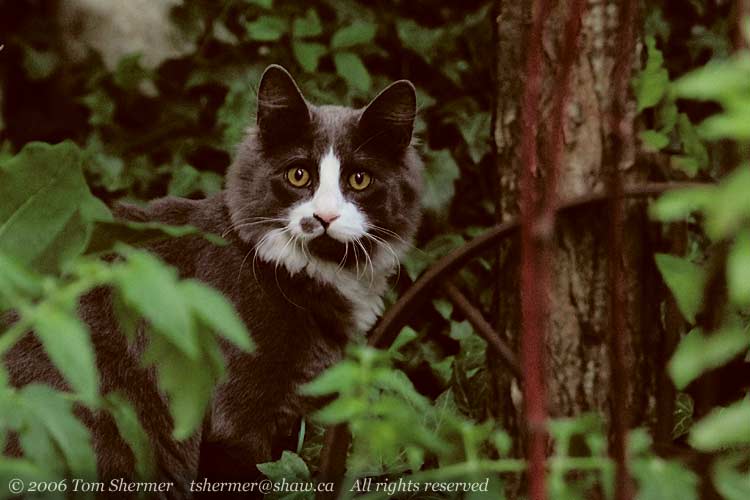 |
|
He's a pretty shy kitty,
and went bounding deeper into the plants almost immediately. I
was happy to have gotten a photo with him facing me full on.
I wasn't quite done
for the day; after going inside and having a soda, I put the macro
lens on my camera and went back out to try to find more insects.
I found a few, but nothing particularly new. First up was an Anthidium
bee nectaring at some Victoria Blue Salvia.
|
|
|
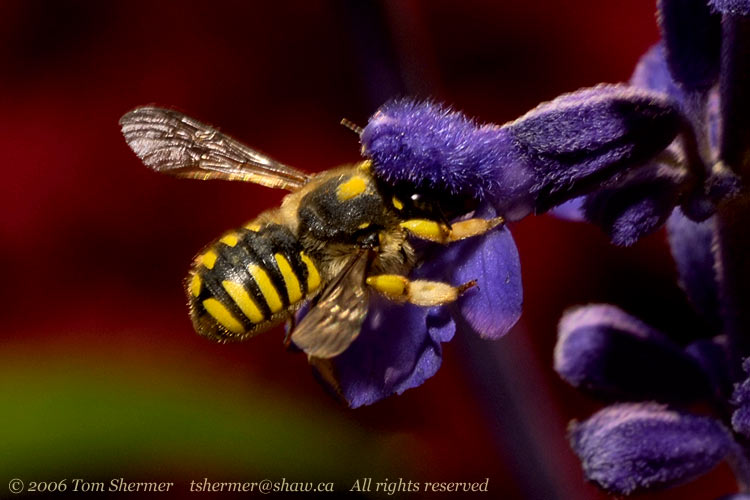 |
|
I guess if you're gonna
nectar, you may as well dive right in.
A little ways along
the waterfront, I found an ant hanging from a spider's web. I
don't know if he was expired, or if he had given up, but he wasn't
moving. But no spider had come out to wrap him up, either.
|
|
|
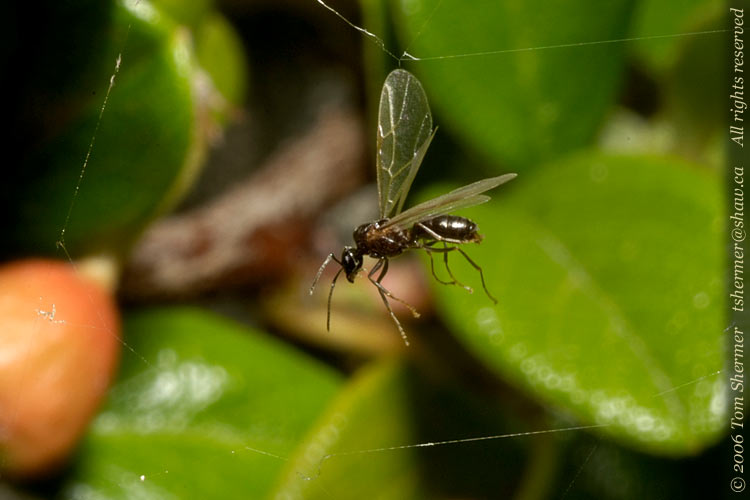 |
| There were
a few spiders around, though. This guy, which I think was a Garden
Spider of some sort (but not our usual tan-and-brown kind), was
only about 15 centimeters away. However, these bushes were thick
with cobwebs, so maybe the ant just wasn't on his web. |
|
|
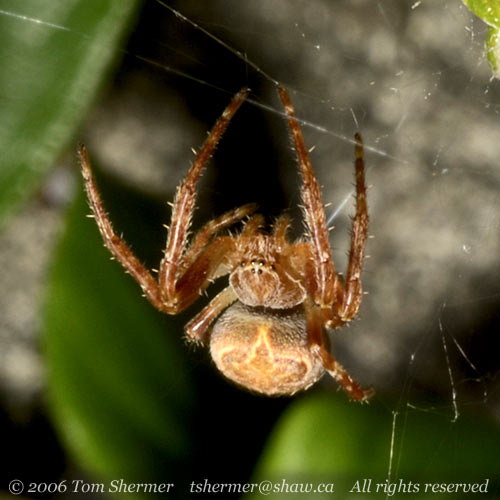 |
|
One thing I like about
that photo is that you can make out six of his eyes on the front
and top of his head. That's a lot of eyes.
I don't know if it's
because I don't have quite that many eyes, or if it's for some
other reason, but in the next little while I was unable to find
anything else that I felt like taking photos of, so that spider
was my last subject of the day.
Your friend with only
four eyes,
Tom
|
|
|